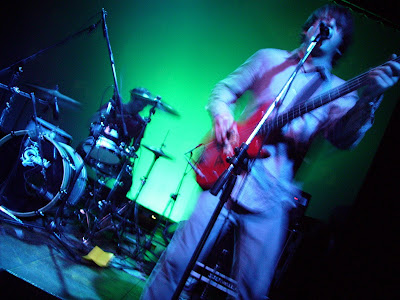
Guided by Voices’ milestone record, Bee Thousand, might make you think that Pete Townshend had a crazy idea one day. It sounds like he put Sonic Youth, Dire Straits, the Modern Lovers and Neutral Milk Hotel in a room with one guitar amp, a bass amp and a drum set and told them all to plug in and start playing without much attention to planning songs or testing levels.
Take that sound; put a heavy emphasis on Sonic Youth; add a bunch of My Bloody Valentine’s hauntingly atmospheric, pounding noise; and tell a pouty girl to shout something infectious over and over into a painfully distorted microphone. Now you have something like Times New Viking.
Sounds terrible, right? To a lot of people, I’m sure it is. But those who can put up with the distortion – better yet, those who can appreciate the scratchy depth that the veneer adds to TNV’s sound – will fall in love. The group recently released a critically acclaimed EP, but TNV novitiates would do well to listen to the trio’s latest full-length, Rip It Off.
Fifteen years ago, Guided shook indie rock with the cage-rattling Bee Thousand, and the parallels between this album and Rip It Off are inescapable. Both bands hail from Ohio. Guided’s seventh record, Bee Thousand was their first to be distributed by Matador Records, and Rip It Off is TNV’s first release on Matador. Each band has a contempt for high-tech recording, rendering their albums unsurpassably visceral—grating in a gratifying way. And in the tradition of punk rock – a categorization both bands consistently sidestep as soon as any critic thinks of conferring it – more than half of the songs on both albums are less than two minutes long; they’re short, fuzzy, hyperactive earworms.
Robert Pollard, Guided’s frontman and only consistent member, had been the victim of feeble success for 10 years. He had tried the high-fidelity studio thing, but he was frustrated with what he described as “sterile” results, not to mention the costliness. The lo-fi sound of a tape recorder became a defining element of the band. But it’s too easy to get hung up on the “noise.” Far from being some elitist, alt-obsessed Luddite, Pollard was a lifelong devotee of the Who with rock-star dreams. (After Bee Thousand launched him into the spotlight, Pollard became renowned for onstage leg kicks and microphone twirls à la Roger Daltrey.) Pollard’s tunes are sing-songy pop, and they whirl around in catchy circles with centripetal motion centered on savvy hooks.
Pollard’s verses hopscotch from opaque metaphor to soaring rock romanticism, often landing somewhere in between. Think of Bob Dylan’s blend of sly-witted metaphor and enamored entreaty on “Queen Jane Approximately,” and throw in some of the epic lyrical simplicity from the Who’s Who’s Next. But they are also surrealist, and often sci-fi-centric. He sings songs called “Hardcore UFOs,” “You’re not an Airplane” and “Kicker of Elves.”
On Rip It Off, TNV takes the Guided paradigm a few steps further in the noise direction. They don’t use a bassist, eschewing their forefathers’ deep, propelling current for a blurrier and more impressionistic sound. TNV create more of an atmosphere than a sum of parts. They also rarely sing harmonies, which are so often part of Guided’s hooks; instead, male and female lead singers often sing in unison or in octaves, and they slather a scraping, trebly distortion onto their voices.
This distortion, another obvious embrace of a “noisy” sound, makes listening to the lyrics a near impossibility, which is a shame because they’re often weighty and contemplative enough to paint gray clouds all over the bright, pop melodies. On opening track “Teen Drama,” TNV warn, “Stop staring at things that are just standing still / Get in line, pretty people, we are coming in for the kill.” Whether you’re following their advice or finding it too difficult to stop dancing, TNV are worth your attention.




